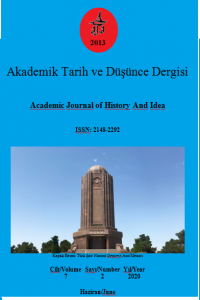Celȃlzȃde Mustafa Çelebi’nin “Tȃrih-i Kal‘a-i İstanbul ve Ma‘bed-i Ayasofya” Adlı Eserinde Hz. Muhammed
Bizans’ın kilisesi, Osmanlı’nın cȃmiîsi
ve Türkiye Cumhuriyeti’nin müzesi olan Ayasofya hakkında inşasından günümüze
kadar pek çok dini, tarihi ve edebi eser yazılmıştır. Bu mabede ilişkin çalışmalar
ve araştırmalar hâlâ devam etmektedir. Bizans döneminde
yazılmış olan İstanbul’un tarihini anlatan “Patria” adlı eserlerin “Diegesis”
denilen Ayasofya hakkındaki bölümleri Fetihten sonra II. Mehmet’in isteğiyle
Türkçe ve Farsça’ya tercüme edilmişlerdir. Bu tercüme faaliyeti daha sonra da
devam etmiş ve böylece Osmanlı döneminde “Ayasofya’nın Tarihi” konulu pek çok
eser meydana getirilmiştir. Gerek Bizans, gerekse Osmanlı dönemlerinde yazılmış
olan Ayasofya tarihleri muhtevaları açısından genellikle birbirlerinin tekrarı
niteliğindedir. Bununla birlikte Osmanlı döneminde oluşturulan eserlerde
Ayasofya anlatımları çeşitlenmiş ve İslȃmî motifler ilave edilmiştir. Bu sûretle Fatih’ten itibaren başlayan çeviri sürecinde oluşan Ayasofya
risaleleri konu, kapsam ve anlatım bakımından birtakım değişikliklere uğramışlardır. Kanuni Sultan Süleyman devrinin önemli devlet adamlarından olan Koca
Nişancı Celȃlzȃde Mustafa Çelebi’nin “Tȃrih-i Kal‘a-i İstanbul ve Ma‘bed-i
Ayasofya” adlı Farsça’dan tercüme ettiği eser bunlardan sadece bir tanesidir.
Bu çalışmada Celȃlzȃde’nin “Tȃrih-i
Kal‘a-i İstanbul ve Ma‘bed-i Ayasofya” adlı eseri incelenecektir.
Öncelikle kullandığımız yazma eserin
nüshaları, bu nüshaların özellikleri ve eser hakkındaki tartışmalar ele
alınacaktır. Son olarak eserin tamamı konularına göre tasnif edilecek ve Hz.
Muhammed’i konu edinen anlatılar değerlendirilecektir.
Prophet Muhammed In Celalzade Mustafa Celebi’s work “Tȃrih-i Kal‘a-i Istanbul ve Ma‘bed-i Ayasofya”
Numerous religious, historical and literary
works have been written about Hagia Sophia which is Byzantine church,
Ottoman mosque and the museum of the Republic of Turkey from construction until
today. Studies and researches on this shrine still continue. “Diegesis” sections which are about
Hagia Sophia of the “Patria” which told
the history of Istanbul and written in Byzantine period were translated into
Turkish and Persian by Conqueror Mehmet’s request after the conquest. This translation activity continued later and thus many
works were created on the subject of “History of Hagia Sophia” during Ottoman
period. The history of the Hagia Sophia, written in both Byzantine and Ottoman
periods, is generally a repetition of each other in terms of their content. However,
in the works created during the Ottoman period, “Hagia Sophia legends” were
diversified and Islamic motifs were added. In this way, the works on Hagia
Sophia in the translation process starting from Conqueror Mehmed has been
subject to some changes in terms of subject, scope and expression. This is one
of the works of Mustafa Celebi, who is one of the most important statesmen of
the period of Suleiman the Magnificent, translated from the Persian name “Tȃrih-i Kal‘a-i İstanbul ve Ma‘bed-i
Ayasofya”. In this study, Mustafa Celebi’s
work “Tȃrih-i Kal‘a-i Istanbul
ve Ma‘bed-i Ayasofya” will be examined. Firstly, the copies of the manuscripts we use, the properties of these copies and
the discussions about the work will be evaluated. Finally, the whole work will
be classified according to the subjects and the narratives about Prophet
Muhammad will be evaluated.
___
- AHMED RESMİ, (1269). Halîfetü’r-Rüesȃ (Sefînetü’r-Rüesȃ), Takvimhâne-i Âmire, İstanbul.
AĞIRAKÇA, A., (2014). “Kaynaklar Işığında İsrâ ve Miraç Olayı”, Artuklu Akademi, Cilt: 1, Sayı: 2. ss. 555-601.
AKGÜNDÜZ, A. – ÖZTÜRK, S.- BAŞ Y., (Mayıs 2005). Üç Devirde Bir Mabed: Ayasofya, Osmanlı Araştırmaları Vakfı Yayınları, İstanbul.
ASLAN, F., (2009). Ayasofya Efsaneleri (Tespit-İnceleme), İstanbul Üniversitesi, Sosyal Bilimler Enstitüsü, Türk Halk Edebiyatı Bilim Dalı, Yayınlanmış Doktora Tezi, İstanbul.
ASLAN, F., (2011). Ayasofya Efsaneleri, İstanbul 2010 Avrupa Kültür Başkenti Ajansı, Kültür Sanat Basımevi, İstanbul.
AYDINGÜN, Ş. G., (2005). “Tarih Boyunca Yaşanan Depremler Sonrası Ayasofya Onarımları,” Deprem Sempozyumu, Kocaeli, 23-25 Mart 2005, ss. 1004-1006.
